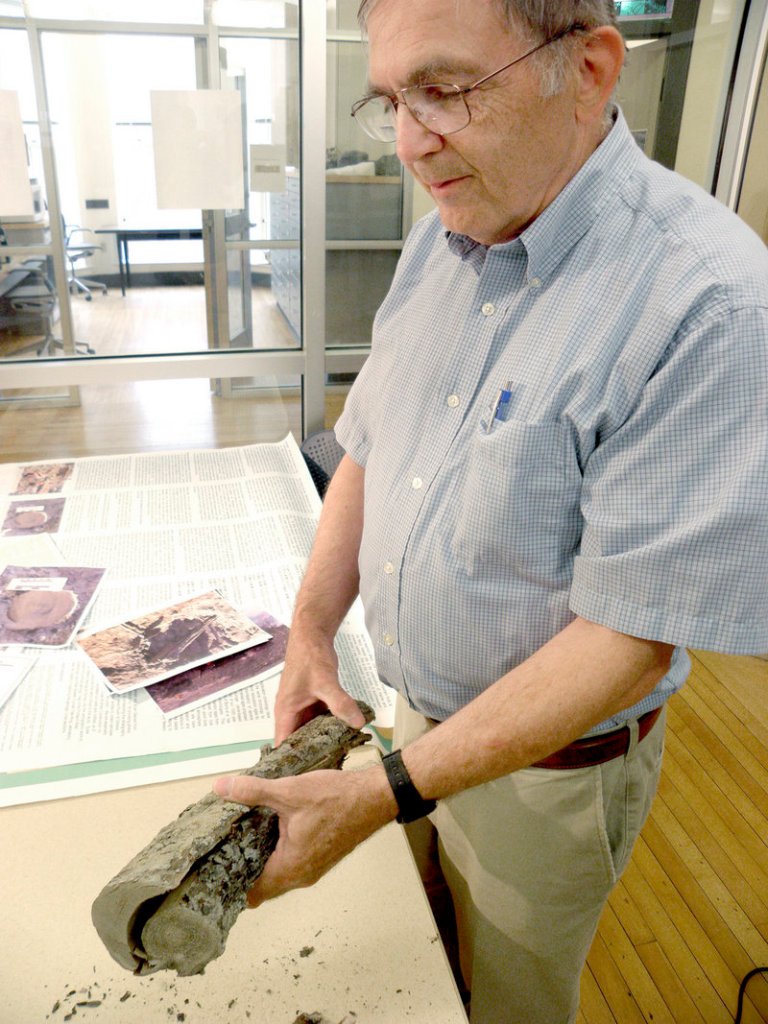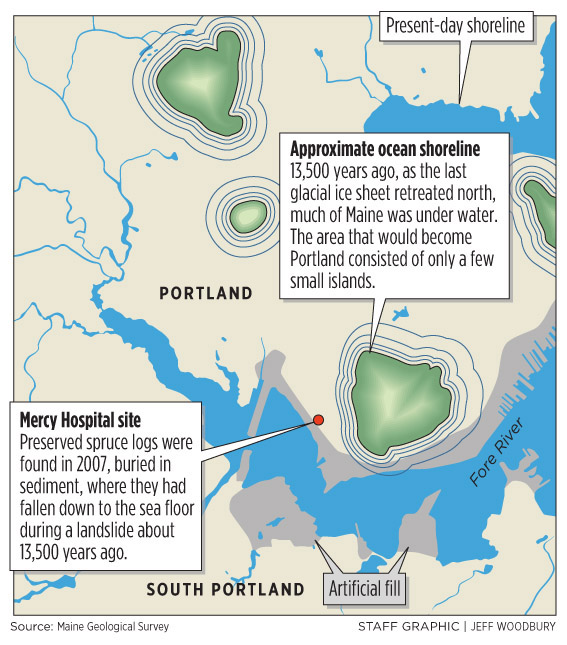PORTLAND – Woodrow “Woody” Thompson was a young geologist in 1976, fresh out of graduate school, when he made a fascinating discovery inside a gravel pit on the west end of Portland’s peninsula.
There, embedded in clay, were pieces of ancient spruce trees.
The fragments of logs and branches, some of them with intact cones and needles that were still green, had been buried in the Presumpscot Formation, a bed of clay that formed on the coast of Maine after the last glacial ice sheet receded about 16,000 years ago.
“It’s fairly common to find the remains of seashells, or at least the impressions, in the formation,” said Thompson, a physical geologist with the Maine Geological Survey. “Preserved wood is much less common. I don’t know of any other place in Maine where any quantity of ancient wood has been exposed.”
While the 1976 discovery helped scientists learn about the ancient forest environment — which turns out to have been remarkably similar to today’s — the preserved wood posed a vexing question, one that would have to wait more than 30 years for an answer.
“How did that wood sink to the ocean bottom and get buried so quickly that they were beautifully preserved?” Thompson said.
He got a chance to answer that question thanks to another find in 2007, just a short walk away from the site of the gravel pit. Excavators working on the new Mercy Hospital campus along the Fore River uncovered much more of the ancient spruce wood, and it was just as well-preserved as the 1976 discovery.
The new materials allowed Thompson — along with colleagues from Cornell University, Colby College, Yale University and the New York State Museum — to learn more about the conditions in Maine about 13,500 years ago. They also concluded that the trees all died at the same time, most likely from a landslide near what is now Portland’s Western Promenade.
Their findings were published this spring in Quaternary Research, a journal that focuses on the earth and environmental sciences.
“This is the same kind of coastal landslide that can happen today,” Thompson said. The researchers concluded that the trees were part of an open spruce forest, and some were older than 200 years when they slid into the ocean.
For many years after his initial discovery, Thompson hoped that a development on Portland’s West End would unearth more of the ancient spruce. He got a call from another geologist who told him about the Mercy Hospital project in 2007. Thompson went to the site and talked with a supervisor from Shaw Brothers Construction, the company overseeing excavation.
The supervisor soon called Thompson on the phone.
“He said they were finding pieces of wood all over the place,” Thompson said.
At one spot where excavators were digging a trench, they found several logs, including one that was dubbed the “telephone pole” for its size. Marine mussel and barnacle shells were found right next to the pieces of wood.
Thompson called Norton Miller, curator and paleobotanist from the New York State Museum, who had helped Thompson with the original find. Carol Griggs, a researcher at the Cornell University Tree-Ring Laboratory, was already in Portland with some of her students because they wanted to visit the site. They were amazed at the condition of the ancient wood.
“They were digging up 4- to 5-foot pieces of logs, up to 10 inches in diameter,” Griggs said.
“We were able to measure the tree rings and found they had been killed in the same year. It was decided that there had been a big landslide at that point.”
Radiocarbon dating showed the trees died about 13,500 years ago. Archaeologists believe human beings were just beginning to establish permanent settlements in North America at that time.
The glacial ice sheet had retreated north, leaving much of eastern and southern Maine under the sea.
More land gradually emerged as the continent, no longer weighed down by the glaciers, rebounded upward.
Researchers believe Portland consisted of a handful of islands 13,500 years ago, including Bramhall Hill, where Maine Medical Center is located.
Pieces of the ancient spruce wood can be seen at the Maine State Museum, the Maine Geological Survey, the New York State Museum and the Cornell Tree-Ring Laboratory.
“It’s very exciting to think that we’ve been able to extend our knowledge about the ancient forest environment of Maine, and provide new information about our seacoast,” Thompson said.
Staff writer Trevor Maxwell can be contacted at 791-6451 or at:
tmaxwell@pressherald.com
Send questions/comments to the editors.




Success. Please wait for the page to reload. If the page does not reload within 5 seconds, please refresh the page.
Enter your email and password to access comments.
Hi, to comment on stories you must . This profile is in addition to your subscription and website login.
Already have a commenting profile? .
Invalid username/password.
Please check your email to confirm and complete your registration.
Only subscribers are eligible to post comments. Please subscribe or login first for digital access. Here’s why.
Use the form below to reset your password. When you've submitted your account email, we will send an email with a reset code.